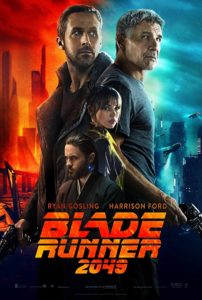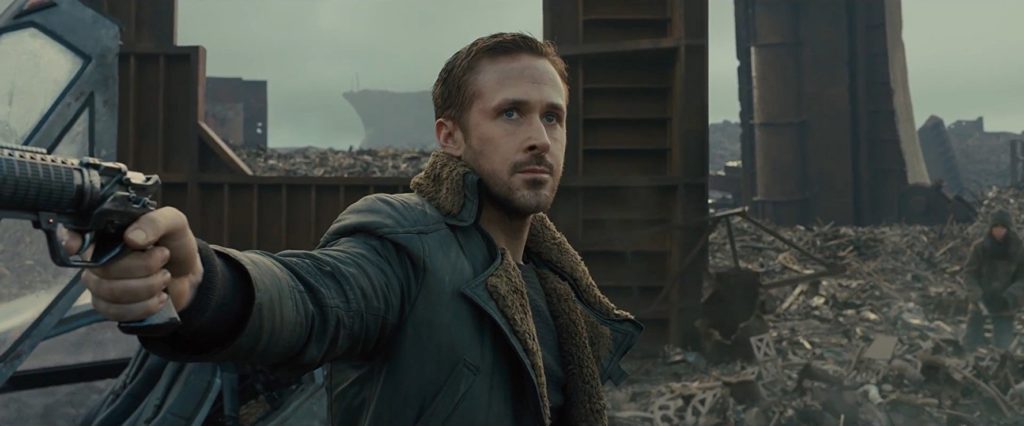Blade Runner Lives! But then again, who does?
DIRECTED BY DENIS VILLENEUVE/2017
 Is Deckard a replicant?
Is Deckard a replicant?
Just after the identity of “Deep Throat” and who the song “You’re So Vain” is about, that has been one of the most persistent cultural questions of the past several decades. Now though, we know the answers to all three.
To be accurate, Ridley Scott, the director of the landmark 1982 “future-noir”, gave his opinion of the matter of Harrison Ford’s character’s genetics nearly a decade ago. Blade Runner 2049, though, seals the deal.
For the multitudes of fans of the original, Villeneuve’s long-awaited follow-up offers no shortage of connections and even conclusions. It takes a certain amount of audacity to put a year in the title of your film, particularly a year that isn’t all that far off. (The year 2049 is about as distant to 2017 as 2001 was to 1968, when Stanley Kubrick released his science fiction masterpiece). It’s akin to advertising an expiration date. But of course, if the 2049 that Villeneuve is presenting comes every partially to fruition, people will have bigger fish to fry than how much the Blade Runner sequel got right or wrong.
If the original Blade Runner has been looked upon as a prime example of postmodern soul searching with a dash of relativism, then how to classify 2049, a sequel that is bigger/everything/more! than its precursor but also, at long last, a quality bookend? Even if the new film doesn’t send viewers away with an impossible list of engagingly ponderous questions, it stirs the existing pot as well as anyone could hope, and leaves audiences fat and happy on its own particular aesthetic world building and a dour presupposition of tomorrow’s U.S. west coast.

One’s level of engagement and appreciation of 2049 can’t help but correlate with one’s own level of reverence for the first film, not to mention one’s tolerance of Ryan Gosling, who’s character dominates most of the proceedings. He doesn’t exactly exude charisma, but then again, neither does the film, nor its predecessor. (Depending on which of the many available cuts of Blade Runner one watches, the level of dour disconnect will be all the more pronounced. Newbies beware of “The Director’s Cut”. For the record, I recommend “The Final Cut”).
Soullessness and existential grappling are dicey subjects when it comes to cinema. Although the work of Ingmar Bergman make it look straightforward, the human interior is all the more rough and complex to communicate in a medium that doesn’t allow for character’s thoughts – not to mention a series like this which has a history of going out of its way to chuck the lead’s voiceover after the fact. Gosling doesn’t say all that much, though his face is deceptively expressive. His sullen semi-stare says pages worth, yet maintains the mystery.
Seeing this film very shortly on the heels of the death of Huge Hefner as well as the single worst shooting massacre in United States history, the peripheral elements of decrepit, detached eroticism with a sandstormed Las Vegas at the hub of it all can’t help but inform the viewing experience. Every city shown, though, has been put through the dystopian wringer. Following a commonly referenced “Blackout”, in which most technology has been wiped out, humankind found itself at a crossroads, then promptly failed to choose a route. 2049 Los Angeles is even more of a soulless panoply of smog and neon than it was in Scott’s film. San Diego is nothing but a vast landfill where L.A. dumps garbage. (Every July, for one week out of the year, I suppose this is true even now.)

Run, Runner!!
Ryan Gosling plays a Blade Runner called K, tasked with hunting down and, if necessary, “retiring” early model replicants, as they’ve long been prone to revolt. Replicants are, of course, genetically engineered artificial life intended for off-world slave labor. An early scene in which K arrives to take down a replicant-in-hiding played by Dave Bautista efficiently lays out both K’s job, and the increased physical strength of such early models. This sequence is the first and last time that any part of Blade Runner 2049 can rightly be called “efficient”.
Harrison Ford of course reprises his role from the first film, though he’s very much in a supporting role this time around. It’s made quite clear how and why Deckard is a changed man after all these years. That said, he remains a man of action, throwing a few of film’s only punches. (Don’t approach this film looking for kinetic set pieces or show stopping action thrills. It’s simply not that kind of big budget blockbuster – though big budget it certainly is). Even as an older man, he’s still fit and looking quite healthy. He gets to spend his part of the movie in one of those cool guy grey t-shirts, scowling a lot.
Clocking in close to the three hour mark, Blade Runner 2049 is both spectacularly immersive and erring on the side of indulgent decompression. While it’s great to be given a lot of time to soak up the impeccable cinematography of Roger Deakins and the physically built semi-dystopian lands of production designer Dennis Gassner, the eventual length of it all is undeniably felt. It’s not a world I was in a hurry to get out of, but it does go on.

There’s a lot about Blade Runner 2049 that should be left for viewers to discover on their own, and an even longer list of things about it that the studio has asked critics not to discuss or make mention of. For this reason alone, the film may warrant a deeper revisitation in coming weeks and months, beyond basic vagaries and glorified thumbs up/thumbs down assessment. Yet, I’m not sure how motivated I personally am to provide such a follow-up.
Most years-after-the-fact sequels tend to ultimately flail in the shadow of their originals, usually becoming pesky little footnotes. (See Tron: Legacy or Texasville). Blade Runner 2049 has a better shot at canonization than most. It asks the big questions, maintains the genre-mashing tone established by Scott, and directly revisits bits and pieces from Blade Runner. It’s a film for the here and now, in that it projects the question about which lives truly matter in a culture built on overt consumption and blatant exploitation.
Despite minor criticisms (and all of my criticisms are indeed minor), Villeneuve has delivered what is an undeniable visual and aural smorgasbord, something that absolutely must be experienced cinematically, and without distraction. (That the latter comment must follow the former is its own sad commentary on mankind). The lonely architecture, the perpetual landscape of a video walls, the persistent background droning sounds, the hum of Hans Zimmer’s score, the arbitrary colors popping through it all… it’s a beautiful nightmare of a possible future, one not all that far off. Gosling is a man alone in the landscape, the center of a very personal mystery that is the singular thrust of this epic undertaking. If the future is now, it is both exciting and terrifying that this is new world of tomorrow. Whom is and isn’t a replicant is almost passé. This is a world without a living end, with humanitarian issues, ethical quandaries, and terminally cool actors to match.


